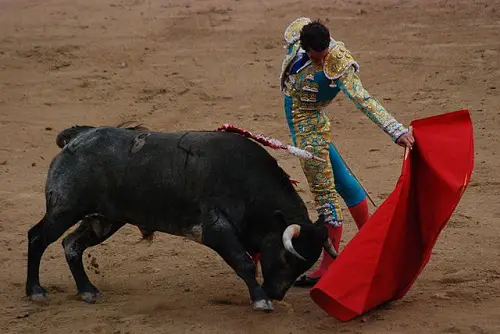
Bullfighting and Barbarism
A Blood Sport in Decline
It seems odd that we still argue as to whether bullfighting is either ethical or does not constitute cruelty to the animal. Those who advocate bullfighting often present a variety of reasons in support of the practice varying from false equivalencies to the slaughtering of animals for meat production to the economic impact if the sport were to be banned. Even how the tradition represents an important aspect of Spanish culture.
Recent polls conducted in Spain show that 81% of those polled have no interest in bullfighting (Winter 2016). This added to the recent announcement by Madrid’s Mayor as to the canceling of an annual subsidy to one of Spain’s most prestigious bullfighting schools and plummeting attendance figures shows that the practice is losing popularity (Schwab 2015). Due to the apparent cruelty on display at bullfights, the U.N. Commission on the Rights of the Child has also put forward a motion to ban children from attending bullfights (Schwab 2015). With such sustained pressure bullfighting’s days are numbered. However, some critics argue that it should be left to die a slow death rather than being banned immediately. This appears to the practical case as powerful interest groups who wield significant influence in government are trying to preserve what they call tradition. That being said the practice has been banned in Columbia and in Catalonia (Schwab 2015).
The following article will present the arguments against bullfighting as well as the bullfight itself. A brief analysis of the actual fight is necessary for proving the cruelty aspect of the argument. I am of the firm belief that the inherent cruelty of the practice is the greatest argument against it. It is this iteration of cruelty that has led to the banning of other undesirable blood sports like bear baiting.
Overview of the Bullfight
The fight can be separated into the actual fight and the pre-fight where the bull is “prepared” for the fight. In the pre-fight the bull suffers terribly, in order to weaken the bull sufficiently it has wet newspaper stuffed into its ears, Vaseline rubbed into its eyes to half blind it, cotton stuffed into its nose to hamper respiration, and a caustic solution rubbed onto the back of its legs to prevent it from sitting down as well as hampering the bulls balance (Bullfighting: The Facts 2017). This, sadly, is not all the bull must endure before being ritually slaughtered. Laxatives are placed into its feed to further weaken the animal and it is kept in a dark box before the fight, as soon as the box is opened the bull charges for the light and into the stadium were odds are it is to be ritually slaughtered for the enjoyment of the crowd (Bullfighting: The Facts 2017).
The actual fight is separated into three “acts” or parts meant to run for approximately 20 minutes. The first sequence of events begins with the picadors on horseback tiring the bull further and using bladed weapons roughly eight inches long and two inches thick called pica into the bull that cause gaping wounds and can result in the bleeding to death of the bull. Then the assistant matadors plunge banderillas, harpoon-like weapons, into the bull. The final act is where the matador kills the bull, this is meant to be done in the most efficient way possible but often tends to prolong the suffering often requiring a further thrust into an artery near the bull’s heart. The bull can take a further three minutes to die (Bullfighting: The Facts 2017).
It is not the bulls that obviously suffer throughout the ordeal. Horses may be injured by the bull in the initial act. Many of these injuries are so severe that often the horse will be put down. One can see that arguments that look to support such cruelty with arguments that it is a fair fight are deeply mistaken. The fight is weighted to the matador considerably. It is true that matadors have died or seriously injured by the bull but statistically these incidents are rare. In light of this, it is important to remember that the matador actively chooses to go into the fight, the bull has no choice whatsoever other than to be ritually slaughtered for those attending.
False Arguments in Defence of Bullfighting
Those looking to defend the practice have relied on a few arguments in the past to justify their position. The one argument that appears to be favored the most is that of tradition and culture. There are records of the sport that date back thousands of years. It is often argued that to ban bullfighting would detract from Spain’s cultural heritage, often arguing that sports like rugby or American football should also be banned (Debate.org 2017). If this argument is accepted than other cruel traditional practices such as female genital mutilation would need to be accepted as well. Even if you wished to apply a measure of cultural relativism to the debate, cruel practices that involve cruelty to animals, or humans for that matter, are unacceptable due to the harm it causes to individuals and society.
Another argument used to defend bullfighting centers around the slaughtering of animals in general. In this argument, it is said that if you eat meat than if you oppose bullfighting you are a hypocrite (Debate.org 2017). This argument rests on a false equivocation between bullfighting and the slaughtering of livestock for consumption. Bullfighting and the slaughtering of livestock are not the same. In the slaughtering process there are regulatory bodies and laws that prevent further suffering and degradation of the animal, often the killing must be done as quickly and humanely as possible. As we have seen there is no similar concern in bullfighting. The cruelty imposed is perpetuated for entertainment.
Lastly, it is often argued that the ban will have serious implications on the Spanish economy (Debatepedia 2017). Often it is said that the bullfights bring in many tourists and boosts tourism to Spain. This was perhaps true in the 60s and 70s were many British tourists believed one needed to witness a bullfight to have a truly Spanish experience. Today though tourist numbers at fights have decreased drastically and with many Spaniards not been interested in bullfighting at all it will be more of a burden to the economy as it will require greater government subsidies.
The Most Important Argument against Bullfighting
There are many arguments against bullfighting, above three rebuttals were seen to arguments in support of the tradition. However, the greatest argument against the practice is the intolerable cruelty suffered by the bull and the needless violence experienced by the horses. Surely, we have no need for such cruel and barbarous entertainment. What value system are we promoting future generations, do we honestly want children to believe that cruelty displayed to animals is morally appropriate. To quote Jeremy Bentham:
“Cock-fights and bull-fights, the chase of the hare and the fox, fishing, and other amusements of the same kind, necessarily suppose a want of reflection or a want of humanity; since these sports inflict upon sensitive beings the most lively sufferings, and the most lingering and painful death that can be imagined.”(Bentham 1802)
Surely such barbarous forms of entertainment cannot be the best representative of humanity. We would condemn such acts if done to other humans, are acts done to animals any different? No as any display of cruelty to those less powerful than us is equally abhorrent.











